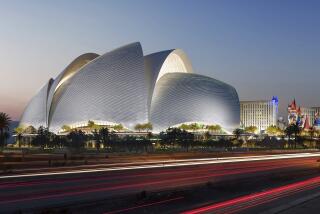Football stadium follies: How the NFL will pick San Diegans’ pockets
- Share via
One must doff one’s hat to the National Football League. Its talent for siphoning money from taxpayers into the pockets of its team-owning billionaires has never shined so bright. The financing plan for a new stadium for the NFL San Diego Chargers, unveiled Monday by a local civic group, sets a new standard for allowing the league to exploit municipal panic and using financial sleight-of-hand to make the process look painless.
The citizens committee proposing this plan actually is proud of its handiwork, calling its financing plan “fair and workable” and praising itself for beating its deadline by four months. “A path to a new state-of-the-art stadium now exists in San Diego,” the panel says. They should have kept working.
Here’s the bottom line. The $1.1-billion to $1-3 billion plan would require contributions of $121 million each from taxpayers of the city of San Diego and the county of San Diego, over time. That’s not counting the proceeds of the sale of 75 acres of public land to private developers, estimated at $225 million, that would go into the stadium as opposed to other civic needs.
Fans would still be expected to fork over $100 million in the form of Personal Seat Licenses (these are licenses allowing them to buy tickets, another scheme largely pioneered by the NFL), ticket prices and parking fees. About $173 million would come from public bonds, backed by team rent. Then there’s the $180 million value of the 60 acres of city land that would be turned over to the stadium project.
The Chargers, who are owned by the Spanos family (net worth, according to Forbes: $1.26 billion), would be expected to put up $300 million. The NFL, which is controlled by a whole passel of billionaires, would put up another $200 million.
What’s most bizarre about this financing plan is that some of its most glaring shortcomings are depicted by the committee as great virtues. For example, it’s supposed to be a positive that the plan doesn’t require a two-thirds vote of the electorate. (Why should the taxpayers have a voice, after all?) That’s because the city and county evidently have the money in their coffers to spend over time without a tax increase.
Of course, that means $242 million unavailable for other civic needs--roads, police, port development, schools, you name it. The committee observes that San Diego voters would “soundly reject” a tax increase for a stadium--or at least the $600 million once being talked about as the public contribution for a replacement for the Chargers’ Qualcomm Stadium.
Choosing to avoid the possibility that voters would reject even $242 million in tax hikes, the committee chose to circumvent the need for any vote at all. To his credit, San Diego Mayor Kevin Faulconer has said he might stage a vote anyway.
There’s still the chance that the Spanos family will reject this deal, if they think the public isn’t putting up enough. The committee says its plan is merely “a blueprint for initiating negotiations with the San Diego Chargers.” Nor should it be overlooked that by some measures, the basic 65,000-seat edifice the committee anticipates will be substandard in the NFL universe, rather than “state-of-the-art”--the minimum the league requires to host a Super Bowl is 72,000 seats.
Let’s keep a clear eye on what’s happening here. The Chargers and St. Louis Rams all are looking for new stadiums built with civic handouts. Their stalking horse is the Los Angeles region, where two separate stadium proposals are moving ahead. As is traditional, the threat of the open franchise slot in L.A. got the incumbent communities’ attention.
As is also traditional, the San Diego financing plan comes dressed up with predictions of all sorts of economic development ripples from events at the new stadium: monster truck jams, concerts, rodeos, dog shows, bar mitzvahs (yes, bar mitzvahs). Last I checked, Qualcomm could accommodate any and all of these, sometimes several at once.
But that’s never the governing factor in NFL stadium politics. The league knows what it wants, and at the top of the list is public money. Our advice to San Diego taxpayers is to get a good grip on wallets: the NFL is wringing, and it’s for you.
Keep up to date with the Economy Hub. Follow @hiltzikm on Twitter, see our Facebook page, or email [email protected].
More to Read
Inside the business of entertainment
The Wide Shot brings you news, analysis and insights on everything from streaming wars to production — and what it all means for the future.
You may occasionally receive promotional content from the Los Angeles Times.











